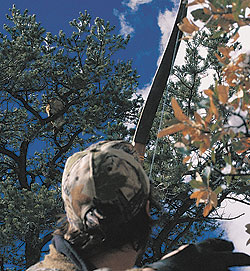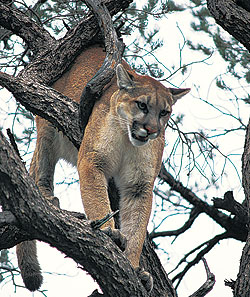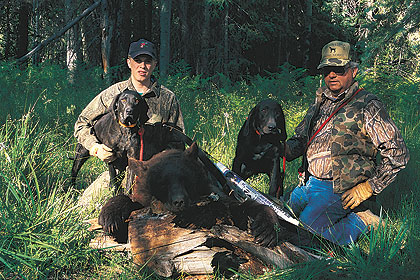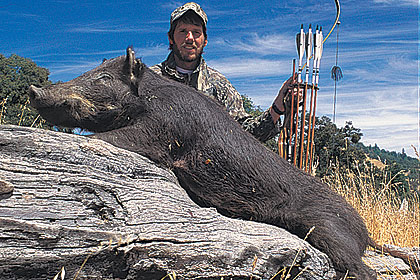October 28, 2010
For Pulse-Pounding Archery Action, Go to the Dogs
By Patrick Meitin
Eons ago, hunting was not the idyllic, sanity-buoying pastime modern Nimrods enjoy.
Back then, a failed hunt spelled hunger or outright starvation. In this life-and-death struggle, early man went to the dogs, manipulating their instinctive hunting style into a convenient alliance. Ever since, man has selectively bred for traits useful to his desires, creating the various sporting breeds we know today. Of greatest interest to big-game hunters are the various hounds, which have a proclivity for relentlessly running game aground while guided by hard-wired olfactory gear evolved specifically to unravel scented code left behind by some of hunting's most elusive and coveted trophies.
Advertisement
Perhaps it's our own latent hunting instincts -- residue from those lean times eons ago -- that makes following hounds in pursuit of game so utterly natural, especially in the case of particularly elusive quarry such as black bears, cougars and wild boars that have turned nocturnal in response to intense hunting pressure. There's something magical and irresistible in the eerie music of singing hounds, akin to the siren's song that once seduced sailors to smash their ships on rocky shorelines.
I quickly weary of those who feign ethical superiority when talk turns to hunting behind hounds and sermonize about a lack of sport, insisting hunters do no more than steal glory rightfully belonging to the dogs. As I've said before, those who speak loudest are typically those least acquainted with the subject. While it is true the outcome of the chase rests largely on the skills of the hounds, without a human element there would be no success. I'll offer no apologies.
Advertisement
 Author Patrick Meitin takes careful aim at a treed bobcat after a spirited chase over snow- and ice-slick cliffs, assembling recurve and arrows beneath the tree after arrival. A couple shots later, the cat would be all his. |
Black Bears: Are You Tough Enough?
The first question you must ask yourself when contemplating a hound hunt for black bear is, "Am I tough enough?" The average bear hunt over bait, or even spot-and-stalk, is fairly relaxed. Chasing bears with hounds is something quite the opposite. Even the most jaded will find no better form of excitement and physical challenge. Spring was once the traditional season (still available in states such as Idaho and Wyoming), but as state game agencies cave to the whims of an uninformed, Disney World-weaned public, fall dates have become more commonplace.
Bear hunting with hounds often involves riding horseback and checking watering sites and food sources until a hot track is found. Many houndsmen cruise back roads in trucks, experienced "strike dogs" used to detect fresh bear scent. Once the chase begins, the occasional bear trees within a few miles -- but I wouldn't count on it. Think five to 10 miles and you're on the right track. If you're lucky, he'll tree near a trail or road where you can ride closer, but I wouldn't count on that either. Fall chases are normally less grueling, since bears have fattened for the winter and are more reluctant to run. But then again, the biggest fall bruins can prove reluctant to tree, resulting in a long ground battle. There's only one certainty when hunting bruins behind hounds -- arrive in top physical shape or you'll suffer.
A change in basic equipment can also make your hunt more enjoyable. Rest assured your favorite compound bow will drive you to distraction, buss cables and limbs hanging on every passing obstacle as you trip and fall and bash your way to a distant tree or ride atop an impatient mount. A better choice would be a rugged takedown recurve (Fred Bear Take-Down, Hoyt Nomad, Martin Jaguar or PSE Coyote, for instance) stashed in a sturdy daypack. Of course, traditional recurves require more investment in practice time for accurate shooting, but keep in mind treed bears rarely require more than 25-yard shots.
 A live mountain lion up close and personal is a sight to behold, something few people are privileged to see, even those living a lifetime in cat country. They are majestically powerful and utterly beautiful and an experience to last a lifetime. |
Takedown arrows can also be fashioned and stuffed into a homemade PVC case with broadheads attached for safekeeping (the G5 Montec, NAP HellRazor, Trophy Ridge Bear Razorhead, Steel Force Phathead and Muzzy Phantom 125-grain cut-on-contact heads all make good choices). The only working combination I'm aware of (perfectly spined to most recurve bows) involves epoxying a short length of 2013 aluminum into a halved 2216. Even on warm days, think in terms of thorn-deterring canvas shirts and pants to minimize bleeding.
It's Like Herding Cats
When it comes to cats -- mountain lion, lynx or bobcat -- there's really no other regular path to success than enlisting the trailing abilities of sharp-nosed hounds. While the long-winded bear can lead hound and hunter on a merry chase, cats are short-winded and typically tree in short order. While the underlying challenge of chasing bears is purely physical, cat hunting is normally all about patience. Cats are inherently clean and normally leave little scent behind, whereas the greasy, carrion-loving bear most often leaves a powerful stink in his wake. Consequently, a viable cat track depends on freshness for success. An effective bear hound is gritty and unrelenting. A good cat hound is patient and cold-nosed.
For this reason alone, the best cat hunts are normally conducted when snow is on the ground and tracks are plainly visible. Outfitters with exceptional dry-ground hounds -- especially in the Southwest -- regularly catch cats without snow, but this requires time and persistence. In snow country, you'll often hunt comfortably from a heated 4WD, keeping a sharp eye on ditches for plainly visible tracks. In other areas, the snowmobile or ATV is the preferred method of transportation. In more remote country, or dry regions, count on covering a lot of ground atop a horse or mule. And in the roughest terrain, it's not uncommon to proceed afoot. Your outfitter will give you a better idea of what you're in for, but it's always best to arrive prepared for a hike.
Takedown bows and arrows are certainly at home on cat hunts, but not absolutely necessary. If you opt for a compound, use a soft case to protect it from bumps and bangs. You can count on a slower pace during the average cat hunt, h
ounds searching and working for each track and trailing for hours -- perhaps all day -- until the cat is jumped or lost. Once jumped, cat chases typically end quickly, though they can offer special thrills and predicaments. Cougars, in particular, often bay in rock and fight hounds on solid ground. Some even seek refuge in caves. These are dangerous times for the hounds, which will make your outfitter as nervous as a Democratic congressman during coming midterms. Shooting can prove tricky, and killing a hound is highly frowned upon. Fortunately, most of the time you'll find your cat in a tree.
 Houndsman Tom David (right), owner of Summit Outfitting, lives for the singing of his hounds during hunts in Arizona's vast White Mountain Apache Reservation, where some of the nation's biggest black bears are taken annually. |
Cold, snowy weather combined with horseback, ATV or snow machine rides require late-season, whitetail hunting garb most already own. During winter forays, expect falling snow; at the least that knocked from passing trees. A wide-brimmed cowboy hat keeps snow from running down shirt collars. Windproof gloves keeps fingers warm and functioning, while insulated hiking boots protect your toes from frostbite and allow a final approach in rough topography.
Poor Man's Dangerous Game
I've accompanied wealthy friends on bowhunts for African elephant and leopard, arrowed a Cape buffalo myself and filmed polar and Kodiak brown bears being shot with arrows. But my most harrowing scraps while bowhunting have arrived courtesy of the lowly feral hog. In particular, I recall a certain 350-pound California boar equipped with five-inch tusks whetted to razor edges that had to be shot off my chest with a magnum handgun. I laugh about it now, but still reach back to finger the lumpy, five-inch scar inflicted to the back of my scalp.
 Author Patrick Meitin took this handsome California hog while hunting with friend Jim Schaffsma of Arrow Five Outfitters. It was later in the week that a much bigger hog wounded Meitin and had to be shot off him with a big handgun. |
This is only one of many harrowing encounters I've survived while bowhunting hogs. The decided difference between the handful of close calls I've experienced and the 50 or so wild boars I've arrowed without incident is that every single brush with wild-hog disaster occurred with hounds in the mix. Inevitably, these tense situations evolve after doing something utterly stupid (fervid determination combined with raw bravado), and my example was a case in point. Hunting tuskers behind hounds can be dangerous; that I can assure you.
Absent hounds, they're normally as shy as whitetail, but drive a hog to the edge with a horde of frenzied dogs and the tables can turn unexpectedly. I'll admit this adds a special charm to the endeavor, as no other animal, besides the grizzly, can prove so dangerous and unpredictable when cornered. This varies according to location, of course. I've met the most belligerent examples in California, Tennessee and northeastern New Mexico (of all places), while it seems those in Texas and Florida -- from my limited experience, at least -- are downright wimpy. It might have something to do with the quality of hounds involved. Who knows? But I've learned not to make assumptions until certain.
Hog chases vary as widely as the animal itself. So, I hesitate to offer fast rules. I've experienced hog chases that ended after a few hundred yards following the jump. I've also run through the night on chases initiated during the light of day. It really depends on what kind of animal you're dealing with. An extremely old boar can prove so used to his position at the top of the food chain he's hardly intimidated by a pack of howling hounds. These you watch carefully. These hogs will hurt you. On the other side of the coin are the endurance runners, which hurt you with miles instead of sharp tusks. One thing remains constant: hogs don't climb trees. Hogs are shot from the ground, normally through gaps in wildly shifting hounds.
If you fail to get off a shot after hounds have brought it to bay, you might just be in for another mile sprint to catch your hog again. A lightweight traditional bow certainly offers toting ease, but unless you shoot it exceptionally well, a compound makes a better choice. Precision is required and accidentally shooting a valuable hound simply isn't acceptable. Cedar or Sitka spruce arrows -- in appropriate deflection -- are welcomed, even from a compound bow, protruding broadheads breaking away easily to pose less risk to hounds. Mechanical broadheads with folding blades are also a good idea for this very reason.
If you're looking for the easy score, hound dogging isn't for you. If instead you seek real adventure, sport as old as the hunt itself and a pure adrenaline rush unlike any other in bowhunting, this mode of operation is a revelation. Like baseball, not every trip to the plate results in a home run. This is understood from the onset or everything to follow is rendered worthless. Don't let preconceived notions or the opinions of the blatantly uninformed deter you any longer; experience the primal thrill that comes with the singing of the hounds.
